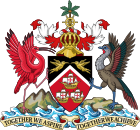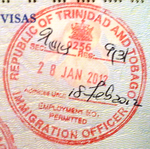 |
|---|
|
|

Visitors to Trinidad and Tobago must obtain a visa unless they are citizens of one of the visa-exempt countries.
Visa policy map[edit]

Visa exemption[edit]
Holders of passports of the following countries and territories may enter Trinidad and Tobago without a visa for the following period:[1][2]
|
Indefinite period 90 days 90 days within any 180 days
30 days |
| Date of visa changes |
|---|
|
Cancelled:
|
Citizens of Argentina, Brazil, Colombia, Costa Rica, Iceland, Israel, Liechtenstein, Mexico, Norway, South Korea, Switzerland, and Uruguay may extend their stay.
Non-ordinary passports[edit]
Holders of diplomatic or service/official passports of China and Haiti may enter Trinidad and Tobago without a visa.
Visa on arrival[edit]
Citizens of Australia, New Zealand and Philippines may obtain "Waiver of the Visa" on arrival at a cost of TT$400. Citizens of other countries who require a visa may also obtain a "Waiver of the Visa" on arrival if they are holding of a copy of a pre-arranged approval from immigration and if they are not citizens of North Korea, North Macedonia, Venezuela or Vietnam, or holders of normal passports issued by China and Haiti.
Visitor statistics[edit]
Most visitors arriving in Trinidad and Tobago on short-term basis were from the following countries of nationality:[6]
| Country | 2016 | 2015 | 2014 |
|---|---|---|---|
| 174,594 | 182,106 | 161,557 | |
| 50,103 | 53,191 | 55,088 | |
| 32,528 | 36,298 | 37,013 | |
| 23,446 | 24,332 | 23,125 | |
| 20,023 | 28,105 | 21,052 | |
| 12,128 | 12,613 | 11,643 | |
| 11,617 | 12,974 | 11,951 | |
| 7,279 | 7,537 | 6,928 | |
| 7,051 | 6,886 | 6,655 | |
| 4,925 | 4,836 | 4,436 | |
| 4,275 | 4,431 | 5,154 | |
| 3,899 | 4,298 | 4,615 | |
| 3,879 | 3,572 | 3,291 | |
| Total | 409,995 | 439,767 | 412,796 |
See also[edit]
References[edit]
- ^ "Visa information".
- ^ "Visa and passport". Timatic. International Air Transport Association through Emirates. Retrieved 1 April 2017.
- ^ LISTADO DE ACUERDOS EXENCIÓN DE VISADO
- ^ "Free entry for Indians, Russians | Trinidad Express Newspaper | News". Archived from the original on 2011-01-03.
- ^ Visas for Venezuelans
- ^ Central Statistical Office – Visitor Arrivals by Nationality
Well, that’s interesting to know that Psilotum nudum are known as whisk ferns. Psilotum nudum is the commoner species of the two. While the P. flaccidum is a rare species and is found in the tropical islands. Both the species are usually epiphytic in habit and grow upon tree ferns. These species may also be terrestrial and grow in humus or in the crevices of the rocks.
View the detailed Guide of Psilotum nudum: Detailed Study Of Psilotum Nudum (Whisk Fern), Classification, Anatomy, Reproduction